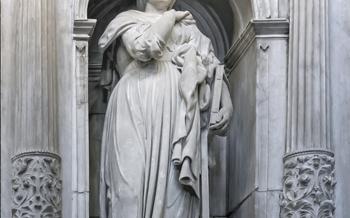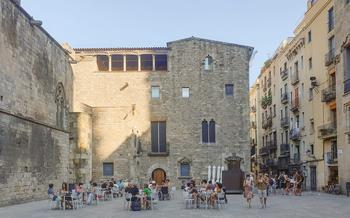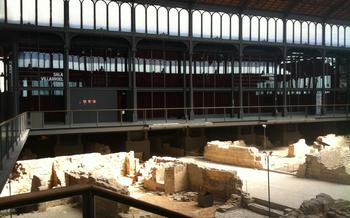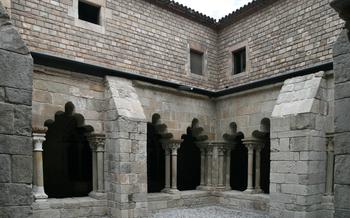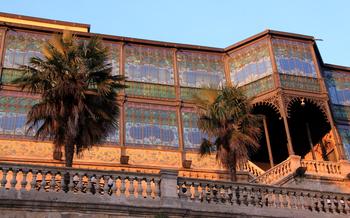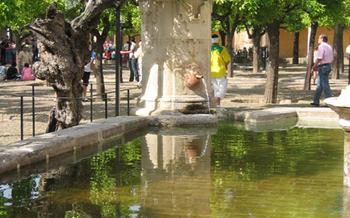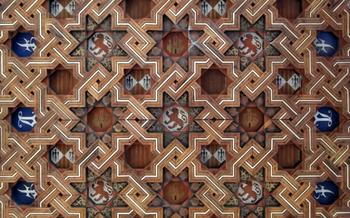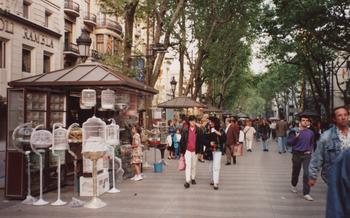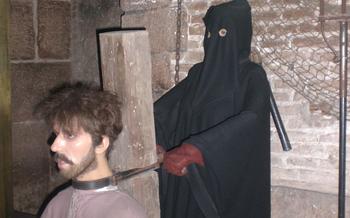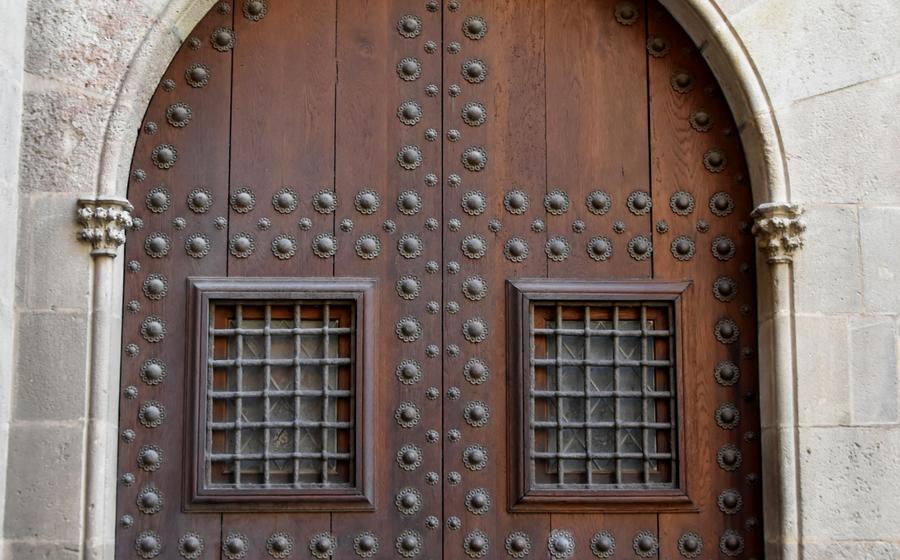
Gothic Quarter
- Getting There
- Wandering the Streets
- Historical Landmarks
- Shopping in the Gothic Quarter
- Nightlife in the Gothic Quarter
- Architectural Highlights
- La Rambla: The Heart of the Gothic Quarter
- Festivals and Events
- Cultural Experiences
- Day Trips from the Gothic Quarter:
- Insider Tip:
Getting There
The Gothic Quarter, the heart of Barcelona's historic center, is easily accessible by various modes of transportation. The metro offers the most convenient option, with the L4 (yellow line) and L3 (green line) stopping at Jaume I and Liceu stations, respectively. Numerous bus lines, including the 47, 59, 120, and V17, also serve the area, providing connections to other parts of the city.
For those arriving by car, finding affordable parking can be a challenge due to the limited space and high demand. Consider using public transportation or exploring parking options outside the Gothic Quarter to save on costs.
Wandering the Streets
In the heart of the Gothic Quarter, where history intertwines with modernity, lies a labyrinth of narrow cobblestone streets, each holding its own charm and character. Embrace the art of getting lost as you wander through these ancient alleyways, allowing the city's captivating allure to guide your footsteps. Discover hidden plazas, adorned with fountains and surrounded by medieval buildings, where time seems to stand still. Step into quaint boutiques, showcasing unique souvenirs and local crafts, or indulge in the aromas of freshly brewed coffee wafting from cozy cafes. Take your time to explore, savoring the ambiance and soaking in the vibrant atmosphere that makes the Gothic Quarter a truly enchanting destination.
Historical Landmarks
In the heart of the Gothic Quarter lies a treasure trove of historical landmarks that whisper tales of Barcelona's rich past.
The Roman Wall: Embark on a journey through time as you explore the remnants of Barcelona's Roman origins, the Roman Wall. These sturdy walls, dating back to the 3rd century BC, stand as a testament to the city's ancient heritage. Follow the wall's path, immersing yourself in the stories of a bygone era.
La Seu Cathedral: Ascend the majestic La Seu Cathedral, an iconic symbol of Barcelona's spiritual and architectural legacy. Marvel at its Gothic grandeur, intricate stained-glass windows, and soaring spires that pierce the sky. Within its hallowed halls, discover a treasure trove of art and history, including the Crypt of Santa Eulàlia, the patron saint of Barcelona.
Plaça Sant Felip Neri: Seek solace and contemplation in Plaça Sant Felip Neri, a serene square steeped in poignant history. Gaze upon the bullet-scarred walls of the church, silent witnesses to the Spanish Civil War. Remember the lives lost and the resilience of the human spirit as you stand in this tranquil sanctuary.
Shopping in the Gothic Quarter
The Gothic Quarter is a shopper's paradise, offering a diverse range of unique souvenirs, handicrafts, and designer items. From traditional Catalan crafts to contemporary fashion boutiques, there's something for every taste and budget.
For souvenirs, head to the stalls along La Rambla or explore the narrow streets off Plaça Reial. You'll find everything from colorful ceramics and leather goods to quirky postcards and magnets.
For more upscale shopping, visit the boutiques along Carrer del Pi or Carrer de la Portaferrissa. Here, you'll find designer clothing, jewelry, and accessories from both local and international brands.
To find the best bargains, visit the markets in the Gothic Quarter. The Mercat de la Boqueria is a must-visit for foodies, with its vibrant stalls selling fresh produce, seafood, and traditional Catalan delicacies. The Mercat del Born is another great option, with a mix of vintage clothing, antiques, and local crafts.
Remember to haggle with the vendors and ask for discounts, especially if you're buying multiple items. And don't forget to enjoy the vibrant atmosphere of the Gothic Quarter while you shop, as it's an experience in itself.
Nightlife in the Gothic Quarter
The Gothic Quarter transforms into a vibrant hub of nightlife as the sun sets. Lively bars and clubs line the narrow streets, attracting locals and tourists alike with their energetic atmosphere. Live music venues offer a diverse range of performances, from traditional Catalan music to international DJs.
For a truly immersive experience, immerse yourself in the pulsating beats of a flamenco show, a passionate and expressive art form that captures the soul of Spain. As you explore the Gothic Quarter at night, remember to prioritize your safety. Stick to well-lit areas, be aware of your surroundings, and avoid isolated streets. With its captivating ambiance and diverse offerings, the Gothic Quarter promises an unforgettable nightlife experience.
Architectural Highlights
Gothic Architecture and Its Influence
The Gothic Quarter is a testament to the enduring legacy of Gothic architecture in Barcelona. This style, characterized by its pointed arches, ribbed vaults, and intricate ornamentation, flourished in Europe during the Middle Ages. In the Gothic Quarter, you can admire stunning examples of Gothic architecture, such as the Barcelona Cathedral, the Palau de la Generalitat, and the Santa Maria del Mar Basilica. These buildings showcase the skill and artistry of medieval architects and craftsmen.
Unique Facades and Intricate Details
As you wander through the Gothic Quarter, pay attention to the unique facades of the buildings. Many of them feature intricate carvings, sculptures, and gargoyles. These decorative elements add a touch of whimsy and charm to the neighborhood. Look for hidden gems such as the Casa dels Canonges, with its beautiful Gothic windows, or the Palau Dalmases, with its elegant Renaissance-style facade.
Barcelona's Architectural Legacy
The Gothic Quarter is a living museum of Barcelona's architectural legacy. Here, you can trace the evolution of the city's architecture from the Roman era to the present day. From the Roman walls to the Gothic churches, from the Renaissance palaces to the modernist buildings, the Gothic Quarter offers a glimpse into Barcelona's rich and diverse architectural heritage.
La Rambla: The Heart of the Gothic Quarter
La Rambla, a bustling pedestrian street, forms the heart of the Gothic Quarter and serves as a vibrant artery connecting Plaça de Catalunya to the waterfront. This lively thoroughfare is lined with shops, restaurants, cafes, and street performers, creating a captivating atmosphere that draws locals and tourists alike.
As you stroll along La Rambla, you'll encounter a diverse array of attractions. Marvel at the intricate architecture of the Palau de la Virreina, a 17th-century palace, or admire the towering Monument a Colom, a statue of Christopher Columbus atop a column that offers panoramic city views.
Don't miss the vibrant Mercat de la Boqueria, a bustling food market showcasing a tantalizing array of fresh produce, seafood, and traditional Catalan delicacies. Take a break at one of the many cafes along La Rambla to savor a refreshing drink or indulge in a delicious tapas meal while soaking in the vibrant atmosphere.
While La Rambla is a must-visit destination, it's essential to be mindful of pickpockets, especially during peak tourist seasons. Remain vigilant and keep your belongings close to prevent any unpleasant incidents.
Festivals and Events
The Gothic Quarter comes alive during festivals and events, showcasing Barcelona's vibrant culture and traditions. The most notable is La Mercè Festival, held annually in September. This week-long extravaganza features colorful parades, live music, street performances, and cultural exhibitions.
Another significant event is Las Fiestas de Santa Eulàlia, celebrated in February to honor the city's patron saint. During this festival, the Gothic Quarter is adorned with lights and decorations, and traditional Catalan dances and concerts fill the streets.
Christmas Markets transform the Gothic Quarter into a winter wonderland during the holiday season. Stalls selling unique gifts, handmade crafts, and delicious treats line the streets, creating a magical atmosphere.
Cultural Experiences
Flamenco Shows
Immerse yourself in the passion and artistry of flamenco, a captivating dance form born in Andalusia and deeply rooted in Spanish culture. Witness the expressive movements, rhythmic footwork, and soulful singing that come together in a mesmerizing performance. The Gothic Quarter is home to several intimate tablaos (flamenco venues) that offer authentic experiences.
Cooking Classes
Discover the secrets of traditional Catalan cuisine with a hands-on cooking class. Learn to prepare classic dishes like paella, tapas, and crema catalana under the guidance of expert chefs. Immerse yourself in the vibrant flavors and techniques that define Catalan gastronomy, and take home a newfound appreciation for the region's culinary delights.
Art Workshops
Unleash your creativity in the Gothic Quarter, a vibrant hub for artistic expression. Participate in art workshops that cater to various interests and skill levels, from painting and ceramics to jewelry making and photography. Engage with local artists, learn new techniques, and create your unique masterpiece inspired by the Gothic Quarter's charm and beauty.
Day Trips from the Gothic Quarter:
The Gothic Quarter offers a wealth of experiences within its enchanting streets, but venturing beyond its boundaries can lead to even more awe-inspiring discoveries. Here are three convenient day trips that can be easily accessed from the Gothic Quarter, offering a delightful blend of history, culture, and natural beauty:
-
Montserrat: Perched atop a mountain, Montserrat boasts a majestic Benedictine monastery that has captured the hearts of pilgrims and travelers alike. Its awe-inspiring natural surroundings, including the jagged peaks of the Montserrat Mountains, provide a stunning backdrop to this spiritual sanctuary. Explore the monastery's sacred spaces, marvel at the iconic Black Madonna statue, and embark on picturesque hiking trails that offer breathtaking panoramas.
-
Girona: A short train ride from Barcelona, Girona transports visitors to a medieval wonderland. Wander through its enchanting cobblestone streets, lined with colorful buildings that whisper tales of the city's rich history. Discover the grandeur of Girona Cathedral, with its Gothic architecture reaching towards the sky. Explore the atmospheric Jewish Quarter, a testament to Girona's diverse heritage. And don't miss the opportunity to savor the city's renowned cuisine, which blends traditional Catalan flavors with modern culinary artistry.
-
Sitges: Escape the urban hustle and bustle with a visit to Sitges, a charming coastal town located just south of Barcelona. With its golden sandy beaches, crystal-clear waters, and vibrant nightlife, Sitges offers a refreshing change of pace. Stroll along the picturesque promenade, bask in the Mediterranean sun, and indulge in delicious seafood delicacies. For art enthusiasts, Sitges boasts a remarkable collection of museums, showcasing the works of renowned artists such as El Greco and Santiago Rusiñol.
Insider Tip:
-
Barcelona Card: Take advantage of the Barcelona Card that offers discounts on public transportation, various museums, and attractions. It's an excellent investment for travelers looking to explore the city comprehensively.
-
Early mornings and evenings: Avoid the throngs of tourists by visiting the Gothic Quarter during the early mornings or evenings. The serene ambiance allows you to fully appreciate the architectural wonders and historical landmarks without the crowds.
-
Learn basic Spanish: Although English is widely spoken in Barcelona, learning a few basic Spanish phrases can significantly enhance your interactions with locals. A simple "Hola" (hello) or "Gracias" (thank you) can go a long way in creating a connection and making your trip more enjoyable.
